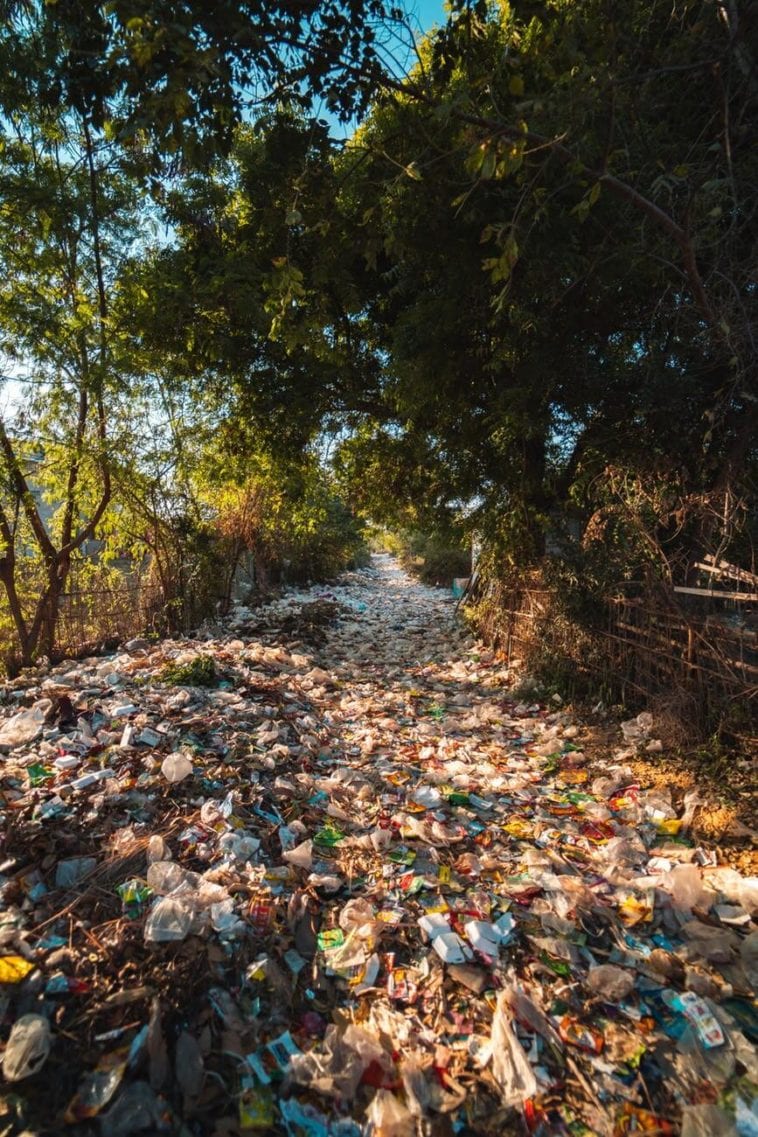We are facing a lot of crises on our planet. One of the most pervasive and life-threatening crises is pollution. We live in a gravely polluted world, brought about by overpopulation and huge industries dependent on fossil fuels.
One of the worst types of pollution is land pollution. But, unfortunately, it also exacerbates other forms of pollution by leaking toxic pollutants into waterways or getting these evaporated into the atmosphere.
Information is key to solutions. So the Zero Waste Lifestyle System prepared this comprehensive guide on land pollution. Here you will learn about its causes, effects, and possible solutions to this global crisis.
Get inspired to work as one to fight pollution inland.
What is land pollution?
Land pollution refers to the degradation of the earth’s soil, both above and below. It encompasses all sort of land pollution which affects any soil: agricultural, forestry, urban, etc. Naturally, this deterioration significantly impacts humans’ livelihood, not that the ocean crisis is not. Still, given the broader perimeters of land, a bountiful amount of livelihood is highly affected.
Causes of land pollution
Any activity that enfeebles the quality of lands for agriculture, wildlife, and whatnot can lead to land pollution. So with that, let us dive into the different causes of land pollution.

The primary cause of land pollutions are because of humans and the wide activities of humans (i.e, littering, washed waste from the ocean, etc.)
Waste
Our garbage, especially plastics, can degrade the quality of the land. Chemicals wearing off from plastics and other waste products that are settling on the land surface gradually contaminate the soil and eventually degrade the surface. The greater the contamination, the higher risk of land pollution. Moreover, these solid and liquid waste materials are often referred to as municipal solid waste (MSW), which consists of hazardous and non-hazardous materials.
Worse than household waste is industrial waste. Chemicals, plastics, oil spills, name it. Despite the fact that the disposal of industrial products is largely regulated, some of the waste still end up in the landfills.
Deforestation and Soil Erosion

According to Earth Eclipse, “Deforestation leads to the total loss of the land’s value. Elimination of natural vegetation disrupts the ecosystem, adversely affecting various life forms.” In addition, when you cut trees, the lands are more exposed to the sun’s heat, which, in return, leads to land pollution, drought, soil degradation, and desertification.
Deforestation leads to soil erosion, a process that turns fertile land into dry land. In short, a land’s alteration and modification can cause an unhealthy effect, which would then contribute to land pollution.
Mining
Mining is so detrimental because it either destroys a land completely or releases toxic chemicals that can harm wildlife and humans’ health. In addition, extraction from the Earth’s core can definitely disrupt the land surface area.
Wastes from mining activities contain a variety of toxic substances that may seep through the soil. Its impact may greatly affect vegetation, especially those that are near the area of mining. This is why mining companies undergo several protocols that must meet the standards of healthy mining, so it is highly assessed to avoid erosions caused by it and other issues that may grow along the way. Massachusetts Institute of Technology said in 2016, ”Mining, like most heavy industries, is dependent on fossil fuels, which generate the energy needed to operate a mine.” Its environmental impacts also victimize humans’ health.
Agriculture

Specifically, agricultural activities. It may sound odd to hear that agriculture may be a factor in land pollution, but it is our dismay. Its agricultural activities, such as fertilization and the spreading of other plant protections that are NOT organic, can contribute to land pollution. (i.e., pesticides and herbicides products)
Often they alter and modify a land according to how their designed ‘agriculture’ ways. But the truth is, it only diminishes the quality of the land and eventually contaminates and destroys it.
Urbanization

The increase in population also increases the possible amount of wastes. Also, to accommodate the rise of the people, more constructions are happening. When it comes to constructions, countless use machines that might emit unwanted gases, and the trash left behind per every construction will either be disposed of properly or dump somewhere, which impacts the environment.
Industrialization

Like urbanization, the higher the population goes, the higher demands (i.e., food, goods, shelter) being produced. This only means more chances of waste being dumped per household.
Nuclear Waste
Nuclear plants cannot help but still emit unwanted toxins in the air or even on landfills. Thus, every toxic chemical emitted which hits the land would put the ground at high risk for contamination.
Effects of Land Pollution
Land pollution can bring greater danger to humanity as much as ocean pollution. The wide perimeters of land all over the Earth is a factor that humans must take into consideration before disposing of their waste improperly – uncontrollably even. Moreover, the regeneration process does not take a minute or so. The greater effects of land pollutions, the more time it needs to recover.
Below are notable effects of land pollution:
Contaminated water

You may wonder why water may get contaminated when we are talking about land pollution. Silly! Of course, there is a possibility for water contamination if land pollution will still arise consistently. Because of unwanted chemicals coming from waste materials, this might be improperly disposed of and end up on groundwater system, which would eventually contaminate it. This process is called leaching, which often happens on farms, industrial sites, and landfills, affecting crops and humans, and animals simultaneously.
Soil pollution
Waste materials with toxic chemicals can contaminate healthy lands and turn them into unhealthy lands. This results in less and less crop yields and, worse, inhabitable areas.
Air Pollution

Non-biodegradable waste that ends up getting burned since it does not degrade on soils can cause air pollution. It could emit toxic chemicals, especially for plastics that release a cornucopia of toxins into the atmosphere.
Change in Climate Patterns
Land pollution can be very dangerous because it can eventually destroy the ecosystem and the planetary balance. It can also affect the way climate occurs in affected areas.
Human Health
Regardless of what kind of land pollution, its effect is dangerous to human health. Contaminated lands because of toxic chemicals can cause fatal problems such as skin cancer and human respiratory problems. Globally, 9,500 people are diagnosed with skin cancer every day. In addition, the toxic chemicals can reach our body through foods and vegetables that we eat as they are grown in polluted soil.
How to prevent land pollution
There are always several solutions lying at the corner with every predicament, waiting for us to pick it up. Given the disastrous effects of land pollution, humans can make several preventions if only we look into it closely. But before we proceed to the preventions, let us first define what pollution prevention is to clear out our main goals for prevention.
According to Stop Global Destruction, “Pollution prevention is any practice that reduces, eliminates, or prevents pollution at its source.” You can apply these pollution approaches to any pollution. This is highly encouraged by all environmental groups to save the environment and humans.
Hence, to reduce the possible impacts of land pollution and stop land pollution itself, here are ways how to prevent land pollution:
For Individuals
Practice the 5 Rs.
Refuse, reduce, reuse, rot and recycle. Waste management, especially in ensuring that as little waste goes to the landfills, is crucial to preserving the dignity of the land. Waste pollution is one of the main culprits of land pollution, and this is one of the most feasible points which we can participate in the solution.
Especially avoid overly packaged items. Go plastic-free, if possible. Plastic packaging lasts too long on land, all the while leaching toxins and destroying the quality of the land.
Keep your surroundings clean.
Not only will you prevent diseases from breaking out in your household and community, you also help protect the land from waste pollution.
Grow your own food organically.
This does not only give a good feeling but grown organic food from your garden is convenient and less costly.
Volunteer and push for better land protection
Volunteer in cleanups, in environmental organizations and regularly connect with your community on engaging your government to implement stringent environmental policies.
Pro tip: Vote for leaders who will commit to protecting the environment – tough on mining and improper waste management, but compassionate for reforestation.
For institutions, governments and companies
Cleanup
Solar Impulse Foundation says, “Environmental remediation consists of removing pollution from the soil, groundwater or surface water. Bioremediation (microbes) and phytoremediation (plants) can be used to convert pollutants into harmless products. These are natural solutions that need to be supported by in-depth actions.”
Like what I mentioned earlier about individual responsibility to keep surroundings clean, governments and other institutions should conduct regular cleanup operations to remove pollution from the land. This is usually the task for the national environmental protection agencies. And for companies, this is a very significant part of their CSR or Corporate Social Responsibility.
Green agriculture
We need to change the way we farm the land. We need to break free from toxic chemical fertilizers and pesticides towards organics. We need to make agriculture sustainable.
We must control the impact on the cultivated environment, by minimizing the external contributions (phytosanitary products), diversifying the crop cultures, and going back to traditionally, non-invasive farming practices.
STOP altering and modifying land qualities as much as possible. This is to keep the lands healthy and strong. Also, good quality and strengthened lands can avoid landslides and erosions.
Governments and agriculture-related industries and institutions are responsible for maintaining the good quality of the land and avoiding the increase of land pollution. This is necessary so that future generations can also benefit from the land.
Reforestation and Forest Protection
Forests are key to protecting the land. Without trees, the land will suffer from erosion. With this, we need to be careful in cutting down trees – make sure that you replace what you take from the land.
Potential healthy barren lands must be planted with either trees or other vegetation that can help preserve the health of the soil. After trimming down trees, let us be responsible enough to plant new seedlings back and plant even more on other parts.
Conclusion
There are many more ways we could do to prevent land pollution. What’s lacking are self-discipline, initiative, and care from the people. Because if EVERYONE, literally everyone, understands the importance of saving the environment and practical enough to become sustainable, it will not be difficult in the coming years to slowly solve environmental problems.
Thus, let us wake up and take a step. A bit of a change can already mean something.




